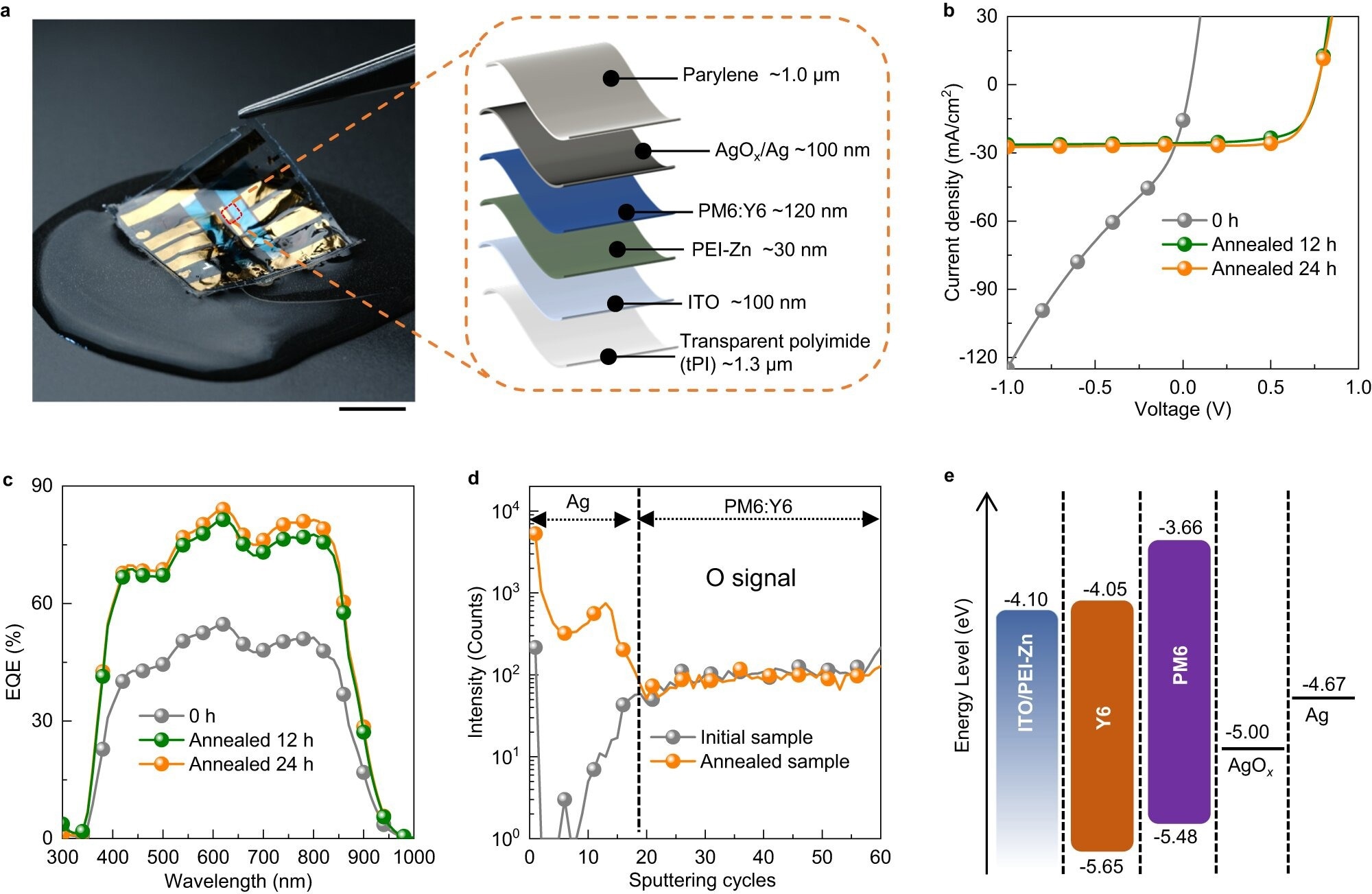Scientists from the RIKEN Center for Emergent Matter Science, in collaboration with partners, have engineered an organic photovoltaic film possessing waterproof and flexible properties. This innovation enables the integration of solar cells onto clothing, ensuring their proper functionality even after exposure to rain or washing.

Structure, characteristics, and mechanism analysis of waterproof OPVs. a Photograph of the ultraflexible and waterproof OPVs floating on water. Schematic device structure of the waterproof OPVs. Scale bar: 1 cm. b J–V characteristics of devices with 0 h, 12 h, and 24 h annealing treatment at 85°C in air. c The evolution of EQE of the OPVs under different annealing times at 85°C. d Depth profiles of O element determined by D-SIMS for initial and annealed samples. e, Energy level diagram of annealed samples. Credit: Nature Communications (2024). DOI: 10.1038/s41467-024-44878-z
Organic photovoltaics hold promise for applications in wearable electronics, such as attaching devices to clothing for medical monitoring without the need for frequent battery replacements. Achieving waterproofing without additional layers has proven challenging for researchers, as it often compromises the flexibility of the film.
Researchers recently tackled a significant hurdle of prior devices, which struggled to maintain waterproofing without compromising flexibility. Photovoltaic films typically consist of multiple layers. An active layer captures the energy of a specific wavelength from sunlight and utilizes it to separate electrons and "electron holes" into a cathode and anode.
These electrons and holes can later reconnect via a circuit, producing electricity. In previous iterations, the layer responsible for transporting electron holes was typically formed through sequential layering. The study was published in Nature Communications.
In the current study, the researchers opted to directly deposit the anode layer, a silver electrode, onto the active layers. This method enhanced adhesion between the layers. They employed a thermal annealing process, subjecting the film to air at 85 ºC for 24 hours.
It was challenging to form the layer, but we were happy to have accomplished it, and in the end were able to create a film that was just 3 micrometers thick, and we looked forward to seeing the results of tests.
Sixing Xiong, Study First Author, RIKEN Center for Emergent Matter Science
The results of the testing were highly promising. They fully immersed the film in water for four hours and observed that it retained 89% of its initial performance. Subsequently, they subjected another film to underwater stretching by 30%, repeated 300 times, and found that despite the rigorous treatment, it maintained 96% of its performance.
Finally, they ran the film through a washing machine cycle, and remarkably, it emerged unscathed — an accomplishment unprecedented in prior studies.
What we have created is a method that can be used more generally. Looking to the future, by improving the stability of devices in other areas, such as exposure to air, strong light, and mechanical stress, we plan to further develop our ultrathin organic solar cells so that they can be used for really practical wearable devices.
Kenjiro Fukuda, Study Co-Corresponding Author, RIKEN Center for Emergent Matter Science
Alongside RIKEN CEMS, the research group comprised members from the University of Tokyo and Huazhong University of Science and Technology in China.
Journal Reference:
Xiong, S., et al. (2024) Waterproof and ultraflexible organic photovoltaics with improved interface adhesion. Nature Communications. doi.org/10.1038/s41467-024-44878-z.